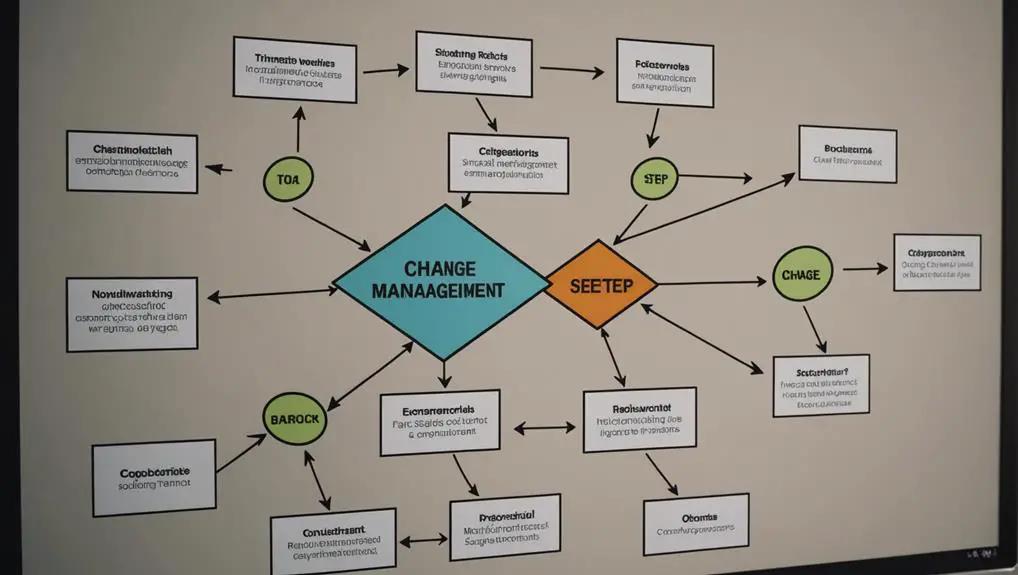As the Change Management Manager in your organization, you are tasked with overseeing the implementation of a new software system across various departments. Your main goal is to ensure a smooth transition and get everyone on board with the changes.
To effectively navigate challenges, clear and regular communication with all stakeholders is essential. Keep everyone informed about the progress, address any concerns or resistance, and solicit feedback for necessary adjustments.
Securing successful adoption of the new software system requires buy-in from key players in each department. Show them the benefits of the change, align it with organizational goals, and provide training and support for a seamless transition.
Understanding your responsibilities as a Change Management Manager is crucial for driving impactful transformations within the organization. By delving into the details of this role, you can improve your ability to lead change effectively and contribute to the organization’s success.
Key Takeaways
Leading change initiatives effectively involves implementing strategies, dealing with resistance, creating detailed change management plans, assessing risks, benefits, and impact, coordinating communication, and ensuring everyone is on board for successful implementation.
Leading Change Initiatives
As a Change Management Manager, your role is to develop and implement strategies that drive successful transformations within the organization. Change management strategies play a vital role in ensuring successful transformations by addressing potential resistance and reducing behaviors that might hinder progress.
Communication and training are key components in preparing individuals for change, fostering understanding, and building support. Effective communication ensures that the vision and goals of the change initiative are clearly communicated, while thorough training equips employees with the necessary skills to adapt to new processes and systems.
Developing Change Management Strategies
When making changes in your organization, it’s important to consider how those changes will affect everyone and look for potential reasons for resistance. By creating solid plans in a step-by-step way, you can help your team accept and adjust to the changes smoothly.
These strategies are meant to help employees navigate through changes smoothly, keep disruptions to a minimum, and get everyone more involved, leading to better project outcomes. Focus on how you communicate, involve key people, provide training, and manage risks to ensure your strategies align with the organization’s goals.
Assessing Impact of Changes
When assessing how changes will impact your organization, consider risks, benefits, and challenges to make informed decisions. Understand how ready your organization is for changes and identify any potential resistance to address them promptly.
Assessing the impact also helps in creating communication strategies that address concerns and facilitate acceptance of changes. This assessment is crucial for managing change and ensuring a smooth transformation process.
Change Consequence Analysis
When analyzing how changes might affect your organization, conduct a thorough analysis of the consequences to spot potential problems, plan solutions, and ensure smooth changes. Focus on identifying risks, preventing them, involving key stakeholders, and keeping everyone informed throughout the process.
Impact Assessment Methods
Use effective methods to assess the impact of changes on people, processes, technology, and culture. Identify risks, resistance, and challenges to make informed decisions and ensure your organization is ready for changes. These assessment methods help in creating detailed plans for managing changes effectively.
Coordinating Stakeholder Communication
When communicating with stakeholders, consider their needs and concerns to tailor messages and communication methods accordingly. Work with key stakeholders to customize communication, gain buy-in, and establish trust and commitment to the proposed changes.
Developing Change Management Strategies
When developing a communication plan, set clear goals, and strategies to cater to the needs of key stakeholders. Craft communication strategies that connect with various stakeholder groups, use different communication channels, and methods to reach a wide audience effectively.
Ensuring Policy Compliance
Ensure organizational policies are followed by regularly updating them, confirming compliance, conducting checks, and addressing policy breaches promptly. Work with everyone involved to ensure policy compliance and encourage responsibility in following the rules.
Monitoring Change Progress
Monitor change progress by tracking timelines, budget constraints, and using KPIs to measure effectiveness. Address delays, obstacles, and resistance promptly, communicate progress to stakeholders, and report on the success of change management efforts for transparency and accountability.
Identifying and Mitigating Risks
Identify and mitigate risks by assessing potential risks, reducing their impact, and proactively managing risks to ensure successful change initiatives. Collaborate with stakeholders, create monitoring systems, and take a proactive approach to risk management for a smooth change process.
Facilitating Training and Support
Facilitate training and support by creating customized programs, offering ongoing guidance, providing clear documentation, and addressing training gaps to help employees succeed during organizational change.
Evaluating Change Effectiveness
Evaluate organizational changes using metrics, feedback, and adoption rates to understand impact, measure success, and make improvements. Use KPIs, metrics, stakeholder feedback, and operational adoption to assess the effectiveness of changes and drive continuous improvement.
Conclusion
As a Change Management Manager, your role is crucial in guiding organizational transformations to success. Embrace your responsibilities, navigate through transformations effectively, and create lasting change in your organization.



